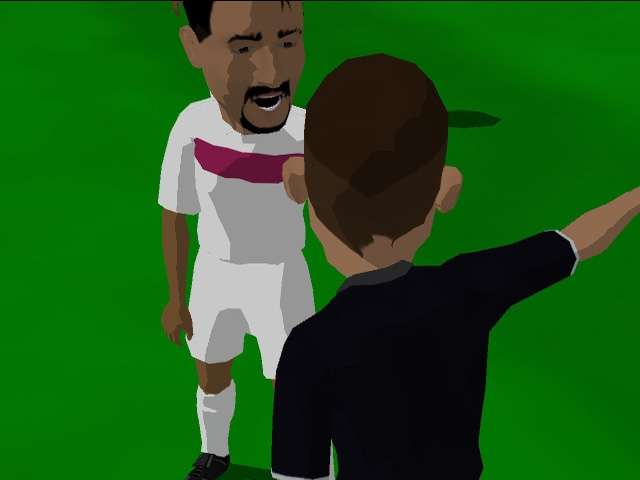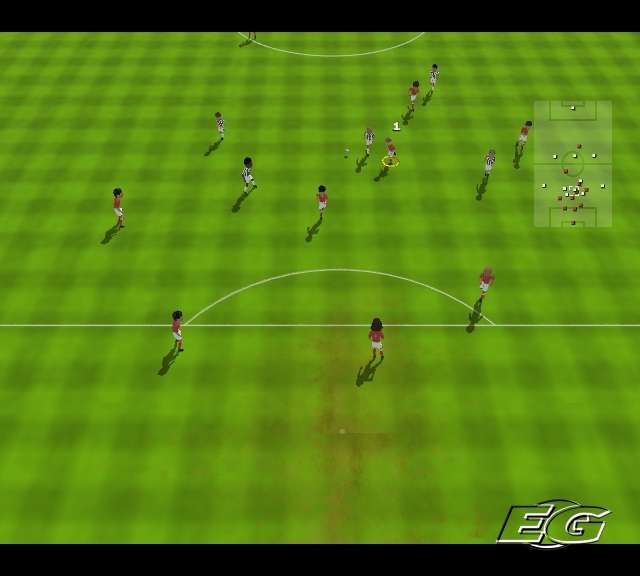Sensible Soccer
Football's coming home.
Comebacks are almost always rubbish. Who can forget Paul Gascoigne's harrowing spiral into League 2 obscurity or the sight of a tormented, chubby Paul Merson waddling out onto the Tamworth turf the other week? It wasn't meant to end this way. They were great players who didn't know when to quit, and it's a painful thing to witness first hand.
Sensible, though, knew when its time was up. Back in '98 it was all-too clear that its Sensi's belated transition to 3D hadn't worked at all, and rather than limp on, the franchise was stretchered off. Sensible sold up to Codemasters, took the money and waved goodbye to its loyal fans with a rueful grin.
With hindsight we ought to be grateful for the fact that Codies decided not to flog a dead horse, for whatever reason. At least we had five solid, happy years to reflect upon between '92 and 97 when successive incarnations of the game completely dominated the scene. And why? For the simple reason that it was the cheekiest, most addictive, and most playable footy game around by some distance.
Sensibilities
Some might argue that no-one's really come close to matching what it stood for ever since, with successive generations of footy games striving for realism over the indefinable fun factor that Sensible Soccer had coursing through its veins right from the kick off. Forget the tiny graphics and rudimentary animation: the instinctive, deceptively deep controls and fluid, hopelessly addictive gameplay earned it a special place in the hearts of millions. Little wonder that people talk about it in such glowing terms even now.

But inevitably some bright spark eventually realised that Sensible Soccer could be brought out of retirement, trained up and thrown into the first team after all - it just needed the right coach. Handily for Codies, Jon Hare's long-standing relationship with the publisher made it an easy fit when discussions about the game commenced last year.
It didn't come out of the blue, though, as long-term fans will be aware, with Kuju working alongside Hare's Tower Studios to produce a mobile phone version of the game back in late 2004. With a hugely positive reaction to the port inspiring confidence, the money men finally realised that such a project had legs, and even managed to persuade Hare to reprise the design role he held throughout Sensible's glory days, and suddenly the Norwich fan was thrown back into to fray to work alongside the Kuju Sheffield development studio.
March Hare

With our extended history lesson over for the day, Hare himself arrived in London and proudly showed the game off to select members of the press for the first time yesterday, and granted us an extended playtest to put his new baby through its paces. After such an extended absence, we were concerned it might miss the point entirely and wind up a pale shadow of the frantic, instinctive action of the original, but we needn't have worried.
Within seconds of picking up the pad (we played both PS2 and Xbox versions during the course of the evening) it definitely feels right. Not in the sense that it feels like the football games of today as such, but that it captures the fast, accurate passing gameplay that has always been the key hallmark of the Sensible Soccer experience. Passes ping with unlikely velocity straight to feet, dizzying manoeuvres are strung together with precision, and booming, curling shots cannon off the upright. The important thing right from the start is it feels exciting, instinctive, and distinctly different from everything currently on the market.
Crucially, the control system is one of the simplest, most intuitive around, yet the 360 degree system pulls it off without losing any depth in the process. Adopting a simple three-button, two-stick system, most of the work on the pitch is carried out with the left stick, in combination with two joypad face buttons (one for pass and another for shots/headers/sliding tackles/crosses). Throw in right trigger for sprinting and the right stick to manually bring out the keeper when required, and you've got Sensible's control set-up in a nutshell.
Reactive

Of course, the context of your actions makes all the difference to what actually happens when you press the button. For example, there are certain zones on the pitch (out on the wing, for example) where hitting the shot button will intelligently cross the ball instead, while a ball played across the penalty box might result in the defender volleying away or heading depending on the flight of the ball and so on.
Unlike pretty much every football game released since, um, Sensible Soccer, you actually have far more control over the power and direction of your shot in way that's both easy to understand and ludicrously straightforward to get used to. For example, when you're on the ball an arrow points out from your player's feet in the direction you're heading. But as useful as this is in stringing together passes, it comes into its own when you're bearing down on goal and looking to fire a missile guided curler past the despairing outstretched hand of the keeper. In a system not dissimilar to the feel of the original, simply holding down the shot button rapidly extends that arrow to give you an intuitive visual clue over both the power and direction. Of course, the next step is to let go, add a bit of aftertouch as required and watch as your piledriver hits the onion sack. Or at least that's the plan.
At this stage, the defending team has the option of relying on the AI and their ability to slide in and defend, or - as a last resort - can push the right stick and take control of the keeper to force them to rush out, narrow the angle and pressurise the forward to fluffing his chance. From a few hours play, it's a remarkably intuitive system that you begin to use more and more (especially during free kicks, where moving the keeper automatically changes the wall positioning), meaning it's actually possible to control the defence and the keeper at the same time - albeit with varying degrees of success that comes at the expense of being able to use the pass or shot button for a split second. It's very much a case of 'use at your own risk', especially given how fast the action is; during a typical game shots will rain down at a pace some footy fans may take a while to adjust to, though current AI balancing suggests that a goal feast isn't necessarily a given.
Good 'ead

As you'll have discerned from the screenshots, the old pseudo top-down viewpoint has been retained, albeit using a scalable view that zooms where appropriate and appears more visibly angled to give you a better view of the big-headed, skinny-bodied players (with widescreen TV owners getting a much broader view of the action, incidentally). But one thing the static images are rubbish at is conveying just how much hilarious character has been infused into each player - not just in terms of the pleasing design, but the enormous range of supremely subtle animations that make it one of the most chucklesome footy games ever, if nothing else.
Although it's not always immediately apparent when playing the game zoomed out, some exceptionally cunning moves often come about from a seemingly innocuous tussle. For example, during a replay you might find out that your attacker actually back-heeled the ball through the defender's legs, or a fouled Spanish player might theatrically collapse clutching their shin in agony when fouled, complete with exaggerated facial expressions. Funnier still is the sight of a defender's reaction upon putting the ball in their own net, or the jubilation that surrounds a goal-scoring celebration. The pseudo-likenesses are genuinely loveable and make you actually crave for the replays far more than you could imagine. Depicted with huge heads and comedy bodies, they're still exquisitely animated, and such subtlety goes a long way to dispelling the notion that this is in any way a technically impoverished game. In motion, it's absolutely delightful.
In terms of general features, Sensible's lack of FIFPro licensing means it fudges the issue in the way that Pro Evo fans will be familiar with from older versions, complete with amusingly misspelt player names that turn out for London Blues and London Reds, for example. Nevertheless, a simple editing system makes it easy to change everything back if these things worry you. In total there will be over 5,500 players (each with their own unique stats and skills), 350 international and club teams to choose from, while each squad will have 16 players, with 12 formations to choose from.
Fact me up

On top of that, you can play two-player co-op games (two on each team), there's all manner of different stadium types, weather types, pitch conditions, kick-off times, save-able replays, over 50 different preset competitions, DIY competitions, league and tournaments for up to 64 players, custom teams that allow you to upgrade players by winning any of the 45 trophies up from grabs, not to mention a host of one-off unlockables - such as comedy hairstyles, kits and boots.
Even from a cursory glance, the game's absolutely rammed with excellent features that will keep everyone occupied for months, though the absence of online play is definitely regrettable - as is the confirmation that the original Sensible won't be featured as an unlockable, sadly. But none of this will matter in the slightest when Sensible comes out in June, because you'll be too busy challenging all-comers on your sofa and marvelling at the joyous return of one of the most cherished brands in the history of football.
Sensible Soccer is released in June on PS2, Xbox and PC via Codemasters. Check back for a full review in the run-up to release.


